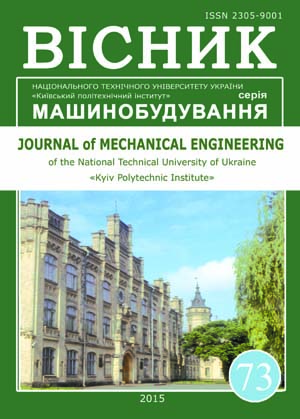MODELLING OF LARGE STRAINS. MESSAGE 5. THERMOELASTICITY
DOI:
https://doi.org/10.20535/2305-9001.2015.73.39410Keywords:
large strains, multiplicative decomposition, thermoelasticityAbstract
It was considered in previous articles (reports 1,2,3 and 4) how the idea of Lee's multiplicative decomposition of the elastic-plastic Cauchy-Green deformation gradient can be implemented to a generalized decomposition of thermal, elastic, plastic and creep deformation gradient and the admissible forms of the constitutive state equations were established. The objective of the 5-th report is to determine which type of the reference configuration 'unloaded' or 'initial' is more suitable in case of thermal-elasticity with respect to general hyper-elastic postulates.
Group properties of reflection operators, the idea of multiplicative decomposition, Second Thermodynamics Law and principle of construction of a functional for a unit elastic free energy as well as a principle of elastic strain determination were used.
It was established that in case of thermal-elasticity the 'unloaded' reference configuration satisfies the general postulates of hyper-elasticity for elastic deformations. However, the 'initial' configuration can be used for calculations because definite transition between two states exists.
Consideration of presented study will help avoid mistakes during calculations of thermal-elastic processes occurring with big deformations.
References
1. Rudakov K.M., Dobronravov O.A. Modeljuvannjavelykyhdeformacij. Povidomlennja 1. Mul'typlikatyvnyjrozkladprynajavnosti chotyr'oh typiv deformacij [Modelling of the large strains. The message 1. Multiplicate decomposition in the presence of four types of strains] Journal of Mechanical Engineering of NTUU «KPI», 2012. no 64. pp. 7–12.
2. Rudakov K.M., Jakovlєv A.І. Modeljuvannjavelykyhdeformacij. Povidomlennja 2. Temperaturni deformacіi [Modelling of the large strains. The message 2. The temperature strains]Journal of Mechanical Engineering of NTUU "KPI", 2012. no.65,pp.10–18.
3. Rudakov K.M., Modeljuvannja velykyh deformacij. Povidomlennja 3. Teoretichni osnovy zastosuvannja logarifmіchnoї mіri deformacії Genkі [Modelling of the large strains. The message 3. Theoretical bases of use of a logarithmic measure of strains of Hencky] Research Bulletin of NTUU "KPI", 2013. no.6,pp. 86–93.
4. Rudakov K.M., Jakovlєv A.І. Modeljuvannja velikih deformacіj. Povіdomlennja 4. Zagal'nі spіvvіdnoshennja termoplas-tichnostі ta povzuchostі pri zastosuvannі logarifmіchnoї mіri deformacії Genkі [Modellingofthelargestrains. The message 4. The physical equations of thermoplasticity and creep at use of a logarithmic measure of strains of Hencky] Research Bulletin of NTUU "KPI", 2013. no.2, pp. 110–118.
5. Lee E.H. Elastic–plastic deformations at finite strains. J. Appl. Mech. (ASME), 1969. 36. pp. 1–6.
6. Sedov L.I. Mehanika sploshnoj sredy [Mechanic of continua] T.1. Moscow: Nauka, 1970. 492 p.
7. Sedov L.I. Mehanika sploshnoj sredy [Mechanic of continua] T.1. Moscow: Nauka, 1994. 528 p.
8. Stojanović R., Djurić S., Vujošević L. On finite thermal Deformations. Arch. Mech. Stosow, 1964. 16. pp. 103–108.
9. Vujošević L., Lubarda V.A. Finite-strain thermoelasticity based on multiplicative decomposition of deformation gradient. Theor. Appl. Mech. Enging, 2002. 28-29. pp. 379–399.
10. Lubarda V.A. Constitutive theories based on the multiplicative decomposition of deformation gradient: Thermoelasticity, elastoplasticity, and biomechanics. Appl. Mech. Rev., 2004. 57. no 2. pp. 95–108.
11. Novackij V. Teorija uprugosti: Per. s pol'sk. B.E. Pobedri [Theory Elasticity] Moscow: Mir, 1975. 872 p.
12. Germain P. Kurs mehaniki sploshnyh sred. Obwaja teorija [Course of mechanics of continuous environments. General theory] Moskow: Vyssh. shk., 1983. 399 p.
13. Korobejnikov S.N. Strogo soprjazhennye tenzory naprjazhenij i deformacij. Prikladnajamehanikaitehnicheskajafizika, 2000. 41. no 3. pp. 149-154.
14. Soprotivleniematerialov. Uchebnikdljavuzov. Podobshh. red. akad. ANUSSRG.S. Pisarenko. 4-eizd., pererab. idop. Kyiv: Vishhashkola. Golovnoe izd-vo, 1979. 696 p.

